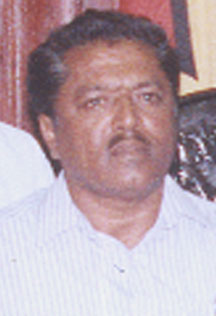Region Two Chairman Ali Baksh on Wednesday rejected claims by the Alliance For Change (AFC) that farmers in the region are beset by a number of problems, including irrigation, a press release from the Government Information Agency (GINA) said.
According to GINA, the regional chairman said that despite having a difficult crop due to the prolonged dry period, the region has already positioned itself to reap 100 percent of production following interventions which have significantly assisted farmers.
The region, with assistance from the National Drainage and Irrigation Authority (NDIA) and the Water Users Associations (WUAs), assisted farmers with fuel and pumping of water from the Pomeroon River into the Tapakuma Lake conservancy, the release stated.
“We have done our best from our side to assist farmers of Region Two. I think some of the statements made are ridiculous and uncalled for and I can assure the public that the majority of farmers would also refute such claims despite the few who have aligned themselves with political parties,” Baksh is quoted as saying.
However the AFC had said that the inefficiency of the Dawa pump near the Pomeroon River was a matter of serious concern, besides other problems affecting the rice industry on the Essequibo Coast.
According to the AFC, this pump which channels water into the Tapakuma Lake and then into the main canal from where rice farmers have access “is not being operated to meet the needs of rice farmers on the coast.”

According to the party, the regional chairman and the vice-chairman had both stated previously that monies that were requested from Central Government were not available to operate this pump to maximum efficiency.
The party had observed also that access roads were very important to rice cultivation but machinery was unavailable to maintain these and the AFC dubbed this as “quite unacceptable.”
But the release said that the regional chairman had assured farmers that assistance would be given to transport produce to the mills, adding that 85 percent of the rice crop is currently at a reaping stage and the dry period has significantly aided the process.
Negotiations
“I don’t know who are giving this false information to say that it is not possible for farmers to transport their produce to the rice mill. With respect to pricing that’s a question for farmers themselves and millers, the region don’t have anything to do with price negotiations and fixing price for paddy,” he said.
Meanwhile, Deputy General Manager, Guyana Rice Development Board (GRDB), Madanlall Ramraj dismissed the claims with res-pect to pricing and reminded that at the beginning of every rice crop it is a norm for the GRDB to post international market prices, allowing farmers to be aware of pricing.
“All information with regards to pricing is there for farmers to see. Take for instance the Venezuelan market, when we had the increase recently of US$800 per tonne for white rice and $400 per tonnes of paddy it was posted, so how can such claims be made?” Ramraj questioned.
The release said further that at the beginning of the rice crop, several meetings were also held with farmers across the country to discuss assistance for reaping. The Ministry of Agriculture also has a system in place through the GRDB and the Rice Producers Association (RPA), which ensures that farmers are given assistance once needed with agricultural machinery and spare parts.
Measures have also been implemented by government to ensure that rice farmers are not ripped off by delinquent millers, the release stated, and so the Rice Factory Act was amended, incorporating measures which would see millers facing the consequences for late payment.
And Chief Executive Officer, NDIA, Lionel Wordsworth highlighted interventions made by government, noting that huge investments continue to be made in drainage and irrigation, especially in Region Two which has seen approximately $240M being spent alone for this year.
He said that there are currently two excavators working in the region at Cozier and on the coast to complete D&I works, including the rehabilitation of several drains, canals and outfall channels.
The AFC, however, had stated that there is a single bulldozer on the entire Essequibo Coast attached to the Drainage and Irrigation Authority and it is used to maintain the access dams that farmers depend on heavily but this bulldozer has been down for the last two months.
According to Wordsworth, in preparation for the dry spell a meeting was summoned where the region’s operations were reviewed to determine suitable responses. At the meeting a decision was taken for the WUAs to provide assistance during this period.
However, he assured that there is currently an adequate supply of irrigation water being supplied to farmers, contrary to what the AFC had said.
“In relation to the preparation of access dams to transport produce from farm to rice mills, while we do not have the direct responsibility, we do support the region and very shortly financing will be provided for the grading of additional access dams in the region,” Wordsworth said.
Over $300M in equipment which included bulldozers and excavators were procured and will be used in various parts of the country to assist in emergency D&I works and prepare access dams.
“There are programmes in place to ensure that access dams are adequately prepared to facilitate transport of produce,” he assured.
Two additional pontoons and an excavator procured at a cost of $244M will be placed in the region shortly to dredge outfall channels along the coast, GINA added.





